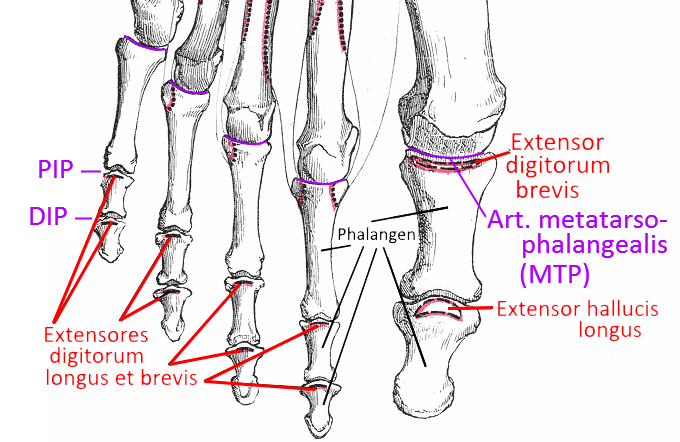
Contents
Toe joints
The toes consist of threephalanges in the case of toes 2-5 and only two in the case of the big toe(hallux). The proximal phalanx is connected to the metatarsal bones, which is why the metatarsophalangeal joints (Artt. metatarsophalangeales) and the interphalangeal joints (Artt. interphalangeales) belong to the toe joints, of which there is one PIP (proximal interphalangeal joint) and one DIP (distal interphalangeal joint), with the exception of the hallux (big toe). In the interphalangeal joints there is only the flexion/extension dimension of movement, in the metatarsophalangeal joints (metatarsophalangeal joints, MTP) there is also radial and ulnar abduction/adduction, which together allow the toes to be spread and spread apart by means of the dorsal pedisinterossei and plantar pedisinterossei.
In contrast to the metatarsophalangeal joints of the fingers (MCP), the metatarsophalangeal joints of the toes (MTP) have a significantly greater range of motion in the direction of extension, as this is required during the rolling process. A noticeable varusor valgus mobility in the interphalangeal joints is pathological and a sign of insufficiency of the collateral ligaments (joint instability).
Metatarsophalangeal joint (MTP)
The metatarsophalangeal joint (MTP) is a two-dimensionally mobile joint: in the direction of flexion and also clearly in the direction of extension as well as medially and laterally (spreading and spreading the toes apart). In contrast to the metacarpophalangeal joints (MCP), extension angles of over 90° are physiological and medium extension angles are commonplace in the rolling motion of the foot. For a more detailed description, see here.
Proximal interphalangeal joint (PIP)
The proximal interphalangeal joint lies between the proximal and medial phalanges and moves the medial phalange relative to the proximal phalange. Like the distal inter phalangeal joint, it only allows one-dimensional movement: Flexion and extension (possibly into slight hyperextension). The PIP has collateral ligaments that absorb movement in the varus or valgus direction.
Distal interphalangeal joint (DIP)
The distal interphalangeal joint is the last on the respective ray and moves the last phalanx relative to the middle one. Like the proximal interphalangeal joint, it only allows one-dimensional movement: Flexion and extension (into semi-significant hyperextension). The DIP has collateral ligaments that absorb movement in the varus or valgus direction.
Articulating bones
- Metatarsals
- Phalanges(phalanges)
Tapes
Ligg. collateralia
The collateral ligaments are strong ligaments that run from proximal dorsal to distal plantar.
Images: (still without)
Lig. metatarsale transversum profundum
Thin profound plantar ligament that connects the metatarsal heads trasnversally and stabilizes the transverse arch.
Images: (still without)
Lig. metatarsale transversum superficiale
Superficial plantar ligament that connects the metatarsal heads trasnversally and stabilizes the transverse arch.
Images: (still without)
Plantar ligament
The plantar ligament of the foot reinforces the metatarsophalangeal joints MTP plantar.
Pictures: (still without)
Pathology
In the area of the MTP: metatarsalgia, hallux valgus, hallux rigidus, hallux limitus,
general: tailor’s bunion, turf toe, sand toe, gout
